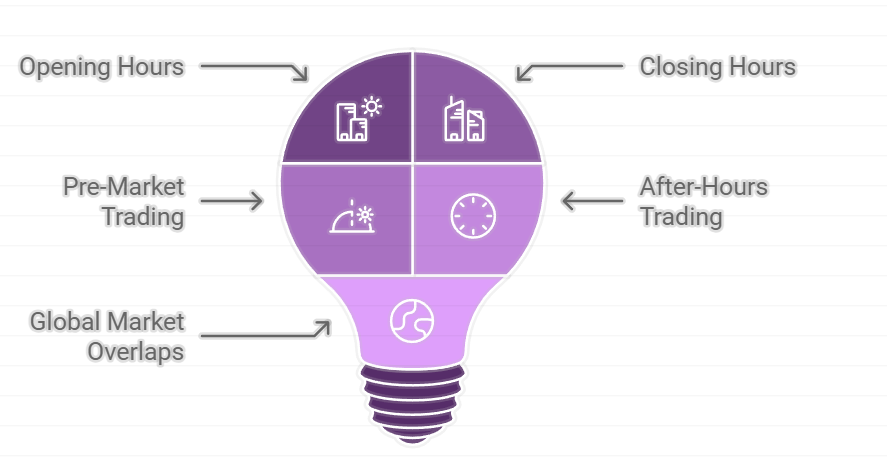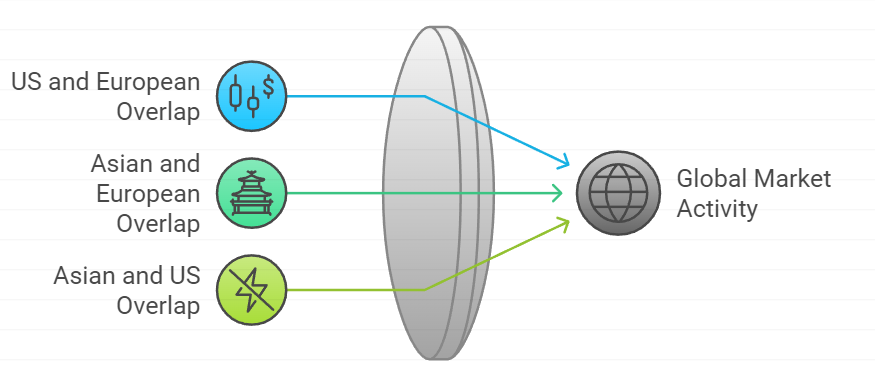For anyone looking to navigate the world of stock market trading, understanding trading hours is essential.
The timing of the markets can significantly impact your trading strategy, execution, and overall success.
This comprehensive guide will walk you through the different stock market trading hours across the globe, explain the importance of after-hours trading, and provide tips on how to optimize your trading activities based on market timing.

What Are Stock Market Trading Hours?
Stock market trading hours refer to the specific times during which stocks can be bought and sold on an exchange. These hours vary depending on the exchange and the region, with different markets operating in different time zones. Knowing when markets are open allows traders to plan their activities, capitalize on market movements, and avoid the pitfalls of trading during low-liquidity periods.
Regular Trading Hours
Regular trading hours are the standard hours during which an exchange is open for trading. Here’s a breakdown of the regular trading hours for some of the major stock exchanges around the world:
New York Stock Exchange (NYSE) & NASDAQ:
Location: United States
Regular Trading Hours: 9:30 AM to 4:00 PM Eastern Time (ET)
Note: The NYSE and NASDAQ are two of the largest and most active exchanges globally, attracting traders from around the world.
London Stock Exchange (LSE):
Location: United Kingdom
Regular Trading Hours: 8:00 AM to 4:30 PM Greenwich Mean Time (GMT)
Note: The LSE is one of the oldest and most significant exchanges in Europe, offering access to a wide range of securities.
Tokyo Stock Exchange (TSE):
Location: Japan
Regular Trading Hours: 9:00 AM to 3:00 PM Japan Standard Time (JST)
Note: The TSE has a lunch break from 11:30 AM to 12:30 PM, during which trading is paused.
Hong Kong Stock Exchange (HKEX):
Location: Hong Kong
Regular Trading Hours: 9:30 AM to 4:00 PM Hong Kong Time (HKT)
Note: Similar to the TSE, the HKEX has a lunch break from 12:00 PM to 1:00 PM.
Euronext:
Location: Europe (multiple locations)
Regular Trading Hours: 9:00 AM to 5:30 PM Central European Time (CET)
Note: Euronext operates in several European countries, including France, the Netherlands, Belgium, and Portugal.
Pre-Market and After-Hours Trading
In addition to regular trading hours, many exchanges offer pre-market and after-hours trading sessions. These extended hours allow traders to react to news events and other market developments that occur outside of standard trading hours.
Pre-Market Trading
Pre-market trading takes place before the regular trading session begins.
Typical Pre-Market Hours: 4:00 AM to 9:30 AM ET (for NYSE and NASDAQ)
Pre-market trading can be less liquid, with wider bid-ask spreads, but it provides opportunities to react to overnight news.
After-Hours Trading
After-hours trading occurs after the regular trading session ends.
Typical After-Hours Hours: 4:00 PM to 8:00 PM ET (for NYSE and NASDAQ)
Like pre-market trading, after-hours trading can be more volatile and less liquid, but it allows traders to respond to earnings reports and other after-market events.

Global Market Overlaps
For traders interested in multiple markets, understanding the overlap between different market hours can be beneficial. Overlaps occur when two or more markets are open simultaneously, leading to increased liquidity and trading activity. Here are some key overlaps:
US and European Markets:
Overlap Time: 8:00 AM to 11:30 AM ET (1:00 PM to 4:30 PM GMT)
Impact: This is one of the most active periods, with high trading volumes and opportunities for traders to capitalize on global market movements.
Asian and European Markets:
Overlap Time: 3:00 AM to 4:00 AM GMT (10:00 AM to 11:00 AM JST)
Impact: While the overlap is short, it still provides opportunities, especially for forex traders and those interested in cross-market trades.
Asian and US Markets:
Overlap Time: There is no direct overlap, but the US pre-market can coincide with the closing of Asian markets.
Impact: This period can be volatile as traders in Asia react to US market news and vice versa.
Importance of Trading During Market Hours
Understanding the timing of market hours is crucial for several reasons:
Liquidity: Liquidity tends to be highest during regular market hours, especially during the opening and closing hours. High liquidity means tighter bid-ask spreads and more efficient trade execution.
Volatility: Market volatility is often higher at the market open and close, providing opportunities for traders looking to capitalize on price movements. However, increased volatility also means higher risk.
News and Events: Major news announcements, such as economic data releases and earnings reports, are typically scheduled during regular trading hours. Traders can take advantage of these events to make informed decisions.
Market Sentiment: Trading during regular hours allows you to gauge market sentiment more accurately, as most institutional traders and market participants are active during these periods.
Tips for Optimizing Your Trading Based on Market Hours
Know the Market Open and Close Times: Plan your trading activities around the market open and close, as these are often the most active periods with the highest trading volumes.
Use Pre-Market and After-Hours Trading Wisely: While extended hours offer additional opportunities, they also come with increased risk due to lower liquidity and wider spreads. Use these sessions to react to news but be cautious of the risks involved.
Monitor Global Market Overlaps: If you trade multiple markets, pay attention to the overlap periods, as these can offer increased trading opportunities.
Stay Informed: Keep an eye on the economic calendar and be aware of key events that could impact the markets. News releases often coincide with market open or close times, leading to increased volatility.
Utilize Automated Strategies: Automated trading strategies can help you take advantage of specific market hours, especially during times when you might not be able to actively monitor the markets.
How QuantL AI Can Help You Trade More Effectively
At QuantL AI, we understand the importance of timing in trading. Our automated trading solutions are designed to help you optimize your trading activities by taking advantage of market hours, liquidity, and volatility. Whether you’re a day trader looking to capitalize on market movements or an investor seeking to diversify your portfolio, our platform offers the tools and features you need to succeed.
Why Choose Our Automated Trading Solutions?
Customizable Algorithms: Tailor your trading strategy to take advantage of specific market hours, ensuring that you’re trading when liquidity and opportunities are highest.
Real-Time Market Data: Stay informed with real-time market data and analysis, helping you make the best decisions during critical trading periods.
24/7 Monitoring: Our automated strategies allow you to trade around the clock, taking advantage of pre-market, after-hours, and global market overlaps without the need for constant supervision.
User-Friendly Platform: Our platform is designed to be intuitive and easy to use, making it accessible for both beginners and experienced traders.
Understanding stock market trading hours is crucial for success in the financial markets. By planning your trades around these hours and leveraging automated strategies, you can enhance your trading performance and achieve your financial goals. Let us help you take the next step in your trading journey. Ready to get started? Visit our website or contact us today to learn more about our automated trading solutions.
For more information on how our automated trading strategies can benefit you, visit quantl.ai or contact us at [email protected]. We’re here to help you make the most of every trading opportunity!





